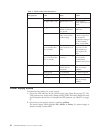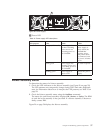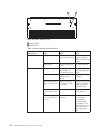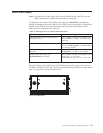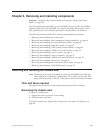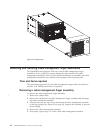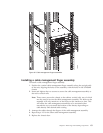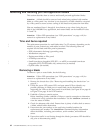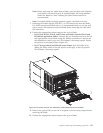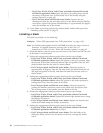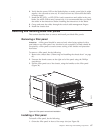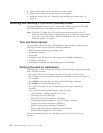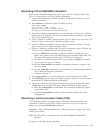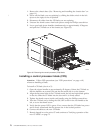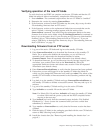
Removing and installing port and application blades
This section describes how to remove and install port and application blades.
Attention: A blade should be removed only when being replaced with another
blade or a filler panel. Any slot that is not occupied by a blade should be occupied
by a filler panel to ensure correct cooling of the chassis and protection from dust.
Slots are numbered from 1 through 8, from bottom to top when facing the port
side of the SAN384B. Port, application, and router blades can be installed in slots
1–2 and 7–8.
Attention: Follow ESD precautions (see “ESD precautions” on page xviii) for
removal or replacement of any blades.
Time and items required
The replacement procedure for each blade takes 5 to 25 minutes, depending on the
number of ports, transceivers, and cables involved. The following items are
required for the blade and filler panel replacement:
v ESD (electrostatic discharge) grounding strap
v Workstation computer
v Replacement blade or filler panel
v #2 Phillips screwdriver
v Small form-factor pluggable (SFP, SFP+, or mSFP) or extended form-factor
pluggable (XFP) (FC10-6 blade only) transceivers (as needed)
v Optical cables (as needed)
Removing a blade
To remove a port or router blade, do the following:
Attention: Follow ESD precautions (see “ESD precautions” on page xviii) for
removal or replacement of any blade.
1. Remove the chassis door. (See “Removing and installing the chassis door” on
page 61.)
2. Check the power LED, status LED, and port status LEDs to identify any
possible problems. A failed port or router blade can be identified by
inspecting the LEDs on the front panel of each blade. See Figure 18 on page 46
to Figure 23 on page 49 for LED locations.
3. Establish a Telnet or console session.
Before installing a blade, establish a Telnet or console connection to determine
a failure and verify operation after installation. Use the slotShow command to
view the status of blades.
4. Check for adequate cable slack. Ensure there is plenty of cable slack to remove
a blade without cable obstruction.
5. Ensure that the part number on the unit being installed matches the
replacement part number. The chassisShow command displays information
about the blades, including part numbers, serial numbers, and additional
status.
6. Ensure that traffic is not flowing through the blade (port status LED should be
off) prior to disconnecting cables.
64 SAN384B Installation, Service, and User Guide
|
|
|
|



